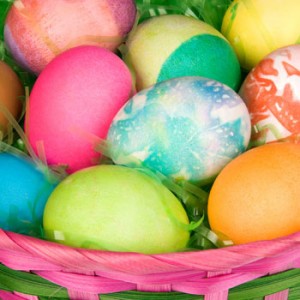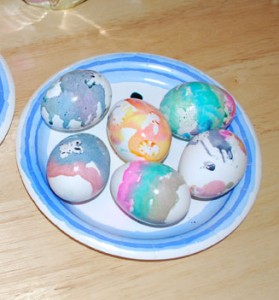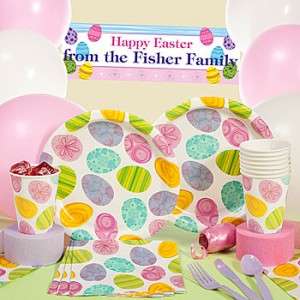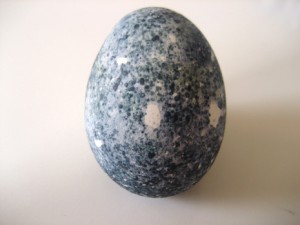Easter Egg Decorating Party
 One of the great traditions during the Easter holiday is the decorating of eggs. We have a lot of fun at our house, as our preschool kids are quickly learning the art of “mashing dye all over the egg until it’s a muddled mess!” Okay, so it’ll take a little time for they’re little Martha Stewarts. In the meantime, here’s a fun idea for an Easter party – both for family, friends, and kids. It’s a fun way to invite a couple of you or your child’s friends over to spend an afternoon decorating eggs.
One of the great traditions during the Easter holiday is the decorating of eggs. We have a lot of fun at our house, as our preschool kids are quickly learning the art of “mashing dye all over the egg until it’s a muddled mess!” Okay, so it’ll take a little time for they’re little Martha Stewarts. In the meantime, here’s a fun idea for an Easter party – both for family, friends, and kids. It’s a fun way to invite a couple of you or your child’s friends over to spend an afternoon decorating eggs.
- Easter Egg Supplies
- Easter Egg Traditions
- How to Boil an Egg
- Food, Refreshments and Decor
- Kids Easter Party Activities
- Food Coloring – Commercial or Home-made
- Creating Artistic Patterns
Easter Egg Traditions
The idea of coloring Easter eggs goes back to the early Orthodox and Eastern Catholic churches, when red dye on eggs was symbolic of the blood of Jesus Christ, and the hard shell represented his sealed tomb. Cracking open the egg became symbolic of Jesus’ resurrection. Over the centuries, artisans from around the world have hand-crafted and decorated eggs to celebrate Easter, and many countries have their own distinct traditions.
In addition to the Christian symbolism, eggs in Slavic cultures represented new life, so their eggs were decorated to honor this notion. A combination of these traditions – along with others that had people offering up eggs as gifts of love, good luck, fertility and friendship – combined to become the ones we know today.
How to Boil an Egg
Prior to the party, you’ll want to prepare your eggs for coloring. A good estimate would be to get about 6-12 eggs for each guest. If you choose to dye the eggs after they are hard-boiled, you can use them afterwards for deviled eggs or egg salad sandwiches. Keep in mind that:
- Fresh eggs that are hard-boiled can be a challenge to peel. It’s best to use eggs that are around two weeks old.
- Pierce the egg in the large end with a needle to prevent cracking and to make them easier to peel.
- Put the eggs in a single layer in saucepan.
- Cover the eggs with water by at least one inch.
- On medium heat, cover and bring to a boil.
- When the water comes to a full boil, remove pot from heat and let it stand for about 15 minutes.
- Drain off the hot water, immediately cover with cold water, and add several ice cubes.
- Allow to stand in cold water until completely cooled.
Food, Refreshments and Decor
Depending on the guests, you can choose to set up an Easter-themed buffet table or individual tables. Snacks should be available, including cookies in the shapes of bunnies or chicks, foil-wrapped chocolate Easter eggs, and marshmallow peeps. Deviled eggs always make a great presentation and are a good light fare for afternoon gatherings. Be sure to provide a variety of drinks.
For decor, choose bright pastels for the celebration of spring. If you are thinking of paper party ware, look for the motifs of bunnies, chicks, hens, and flowers. Leftover garden themed plates are great, too. You can find Easter-specific supplies online at the following stores:
Kids Easter Party Activities
Depending on the ages of the guests, you might want to have an Easter game available while everyone is arriving. Pin the Tail on the Bunny can be a good one (one year we did “put the egg in the basket”.) Another idea is to let the children help you prep for the actual coloring of the Easter eggs by dissolving color tablets, cutting or arranging food items to be used, and setting the table or work station.
Food Coloring – Commercial or Home-made

Our two year old’s first attempt at decorating eggs!
You have a choice nowadays to color your Easter eggs in either the traditional manner (using a commercial Easter egg dye), or creating your own. If making the colors yourself, you will likely have the materials already in your kitchen cabinets. All you need is food coloring, vinegar and water. To create nifty patterns, have some herbs and vegetable peels at the ready. See below on how to do this.
Remember, though, that the actual process of coloring eggs can be messy, so don’t dress your child in white! In fact, you might consider having your guests wear old shirts and even disposable gloves. If anybody accidentally touches the dye, don’t worry. Food coloring does wear off and will not hurt the children.
Here’s how to make your Easter egg dye:
In small heat-proof custard cups or glasses, add one cup of boiling water, a tablespoon of vinegar, and about 30 drops of food coloring. Have separate spoons for each color.
Using the primary colors of red, blue, and yellow dyes enables you to create most colors in the spectrum.
- Red + yellow = orange
- Blue + yellow = green
- Red + blue = purple
Experiment with adding different quantities of drops to make different colors.
Using Natural Coloring
Using natural food coloring is becoming more and more popular with environmentally conscious parents today. If you decide to do this, either prepare in advance or, if the party will be a long one with other activities, everybody can pitch in to create these dyes together. However, since they take time (about half an hour of simmering, never mind the chopping of the vegetables and cooling down period), some colors will take time to make.
To make any of these colors, chop up the required vegetables and/or scraps (about 2 cups, packed), a tablespoon of vinegar, raw eggs, and fill with water. Here is a list of natural ingredients and their resulting colors:
- Red = red onion skins; red or red wine vinegar
- Orange = calendula or marigolds (just the flowers)
- Yellow = turmeric or orange/lemon peels
- Yellow/orange = shredded carrots
- Green = grass or fresh spinach
- Blue = fresh red cabbage (yes, red cabbage) – warning, this will be stinky!
- Purple = fresh blueberries, beets
- Lavender = grape juice or concord grapes
- Brown/Tan = yellow or white onion skins, tea or coffee, black walnuts
- Brownish/Orange = chili powder
Watch the video below on dying an egg using purple cabbage, water and alum powder.
Creating Artistic Patterns
To create some nifty and artistic patterns on your eggs, try herbs and vegetable peels! If you don’t have these available, supermarkets might offer you onion skins or spinach scraps for free, especially if you explain to the manager that you need them to dye Easter eggs.
- Wrap wet raw eggs in wet onion skin, add add herbs or bits of various vegetables between for designs); loosely wrap egg in cloth secured by a rubber band; drop eggs in boiling water for about 7 minutes; cool with cold water; unwrap and be ready for a delightful surprise.
- Prior to dropping the eggs in the dye, have the kids try drawing words or pictures on them with various colored crayons. (It’s much easier to write on warm eggs.)
Have a colorful and creative Easter egg decorating party!

